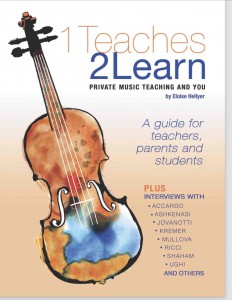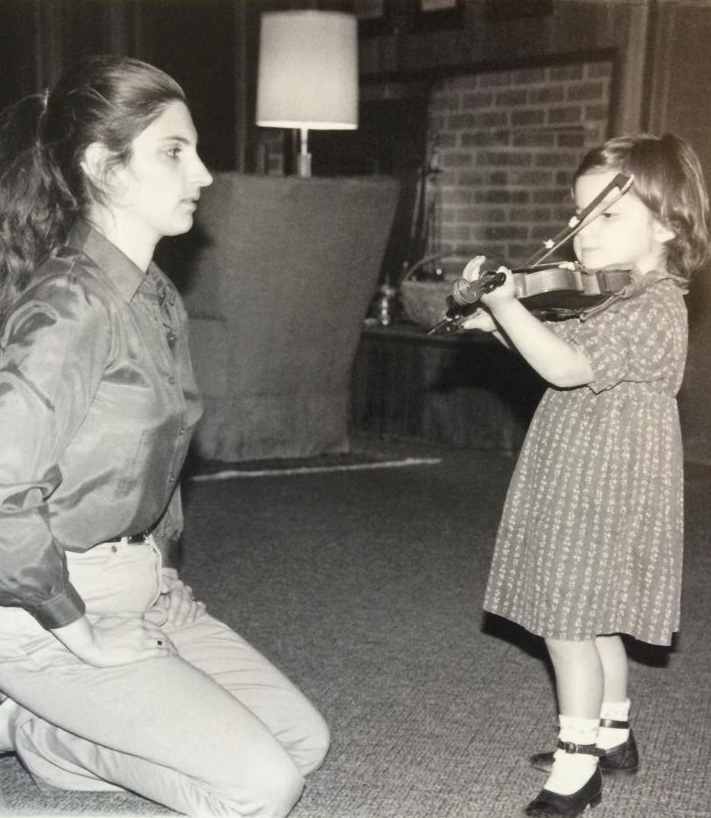Beautiful Heart, Beautiful Tone or Is It Vice Versa?
Recently, a teacher/researcher asked an interesting question on an Internet forum: What did Suzuki mean by the phrase “beautiful tone, beautiful heart”? What was the connection he made between tone and character?
Did he mean that a beautiful tone led to a beautiful heart? But Helen Brunner, who we all know spent a lot of time with Dr. Suzuki, wrote ¹ that he always said, “Beautiful heart, beautiful tone.” So what did he mean?
Suzuki was close to becoming, if he was not already, a realized being. It didn’t matter to him what the order of his words was. He knew what he meant. But most of us more earthbound beings tend to take such sages’ words fairly literally. Words (especially translated ones) are a rather poor way of transmitting what is essentially a spiritual concept. Suzuki even seemed to contradict himself on occasion.
If a musician wants to become a fine artist, he must first become a finer person.” ― Shinichi Suzuki, Nurtured by Love: The Classic Approach to Talent Education
“Our aim needs to be the nurturing of children. The moment we rigidly convince ourselves, “Education is what we’re after,” we warp a child’s development. -1- First foster the heart, then help the child acquire ability. This is indeed nature’s proper way.” ― Shinichi Suzuki, Nurtured by Love
But then he says:
“Teaching music is not my main purpose. I want to make good citizens. If children hear fine music from the day of their birth and learn to play it, they develop sensitivity, discipline, and endurance. They get a beautiful heart.” ― Shinichi Suzuki
So, again, which comes first? Beautiful tone or beautiful heart? What should be our goal? A beautiful tone will then promote a beautiful heart, or should we work on developing a beautiful heart that will definitely help produce a beautiful tone? Should we, and can we actively work on both? And how?
One commenter on that post remarked that teachers often focus too much on a beautiful tone without teaching a beautiful heart. I agree, but I think that many of us feel it’s not our purview to talk about the spiritual aspect of music. But if we want to cultivate actively the appreciation of beauty in our students instead of leaving it up to “talent,” as so many teachers have done in the past, we may have to.
So how do we teach both? Indeed, what is a beautiful heart?
My definition as far as music is concerned is that it is one that searches for beauty and tries to reproduce and transmit it to the world. We cannot create beautiful hearts in our students, but we can certainly encourage their formation by teaching children about beauty, what it is, and how important it is to create it and transmit it to others. And this can start with the first lesson.
But which is it? Which comes first: the chicken or the egg? Heart or Tone?
Neither. While they can be sequential—one leading to the other—they can also be developed together. The appreciation and understanding of beauty are essential to developing a good tone, just as learning to have a good tone furthers good taste and the desire to create beauty.
After all, what does the search for a beautiful tone mean about our character, our heart, or our soul? There is a big difference between making noise and deliberately making a conscious, constant, and concerted effort to put more beauty into the world.
And here is where teachers can make a difference: we must give our students not only the physical technique needed to create a beautiful tone but also reasons and motivations to do so. The first time they put their bow on the string, we can stop them afterward and say, “Did you hear that? Wasn’t that beautiful? Aren’t you happy you can do that? Aren’t you thrilled that you have put a little more love out into the universe? Let's do it again!” We must help them understand that music is important, that their playing is important, and that we can all create beauty with only one note if our intention is pure. We can help them understand that playing music is not only a privilege but a responsibility: the better you play, the more responsibility you have to ensure that you create beauty, and that while this world can be ugly, we can all do our bit to make it better. And that playing even the “Twinkles” well is important for here and now.
As for what a beautiful tone is, I don’t think you can objectively qualify and quantify sound or tone. But you do know when you hear something beautiful being transmitted by someone who wants to create beauty.
And that’s where character or heart comes in. If a child realizes that he can produce beauty and that it is indeed his responsibility to do so, it forms his attitude toward music as well as toward life in general. Imitation is one thing. Deliberately setting out to imitate something beautiful while being aware that it is beautiful, which means playing from the heart too, is another thing altogether.
Playing music for others is an act of generosity—sharing something beautiful. We can teach it this way. Or we can teach it as an act of ego: you have to be better than others; you must never make a mistake; you must put your stamp on the music; you must do something never done before.
We can teach our students to connect themselves to the universe via their hearts, souls, or minds (whatever you want to call it) so that they can transmit beauty. Or we can teach them, actively or tacitly, that they have to show the world how good they are: that it's all about them.
Of course, a certain amount of ego is necessary to get a performer up on that stage. However, the great artist is one who uses her ego so she will perform but, once onstage, thinks only about transmitting the music she has so carefully prepared, trying to understand why the composer wrote what he wrote, and trying to transmit that composer’s intentions. Ego performers can be great fun to listen to, but the ones who truly touch you, the great artists, are the ones who play from the heart which, at the time he or she is playing, is beautiful.
Yes, the annals are full of great artists who weren’t very nice people, as another commenter succinctly pointed out. Indeed, being a great artist is no guarantee that you are a great human being. But violin as well as other instrument teachers have the possibility to try to cultivate from the first lesson not only good musicians but also generous, kind, caring, artistic, and responsible people who understand the importance of creating and transmitting beauty, all of which surely should have an eventual effect on the rest of their lives.
Even if it doesn’t and even if we don’t always succeed (and we can all think of a few appalling examples of beautiful music and awful morals and behavior), we have to try.
Wasn't it Keats who wrote, "Beauty is truth, truth beauty,—that is all Ye know on earth, and all ye need to know.”?
Teaching our students to search for beauty and the truth behind it, to stay true to the intentions of the composer instead of the calls of their egos, to understand the importance of transmitting something beautiful, and to carry these values into their daily lives, all constitute the great privilege and responsibility we have as teachers.
After all…
“What is man's ultimate direction in life? It is to look for love, truth, virtue, and beauty.” ― Shin'ichi Suzuki
If our teaching makes our students aware that by playing music they are effectively making such a search, and if we help them understand the importance of transmitting what they find to others, we will certainly help them develop a beautiful tone that is inseparable from a beautiful heart (or vice versa), which will serve them and others for the rest of their lives.
Share this:
Buy it on www.sharmusic.com - eBook format, avaliable worldwide, paperback in North America
COPYRIGHT
ABOUT
A music teacher’s thoughts and observations on the teaching and the study of a musical instrument, hoping to be of help to parents, students and teachers.
PHOTO
AWARDED TOP 25 VIOLIN BLOG
CATEGORIES
TAGS
ARCHIVES
-
Agosto 2022
Agosto 2023
Agosto 2024
April 2015
April 2016
April 2017
April 2019
April 2020
Aprile 2022
Aprile 2023
Aprile 2024
August 2014
August 2015
August 2016
August 2017
August 2018
August 2019
August 2021
December 2014
December 2015
December 2016
December 2017
December 2018
December 2019
December 2020
Dicembre 2022
Dicembre 2023
Dicembre 2024
Febbraio 2022
Febbraio 2023
Febbraio 2024
February 2015
February 2016
February 2018
February 2019
February 2020
February 2021
Gennaio 2022
Gennaio 2023
Gennaio 2024
Giugno 2022
Giugno 2022
Giugno 2023
Giugno 2024
January 2015
January 2016
January 2017
January 2018
January 2019
January 2020
July 2015
July 2017
July 2019
June 2016
June 2017
June 2018
June 2019
June 2020
June 2021
Luglio 2022
Luglio 2023
Luglio 2024
Maggio 2022
Maggio 2023
Maggio 2024
March 2015
March 2016
March 2017
March 2018
March 2019
March 2020
March 2021
Marzo 2022
Marzo 2023
Marzo 2024
May 2015
May 2016
May 2018
May 2019
May 2020
November 2014
November 2015
November 2016
November 2017
November 2018
November 2019
November 2021
Novembre 2022
Novembre 2023
Novembre 2024
October 2014
October 2015
October 2017
October 2018
October 2019
October 2020
October 2021
Ottobre 2022
Ottobre 2023
Ottobre 2024
September 2014
September 2015
September 2016
September 2018
September 2019
September 2020
September 2021
Settembre 2022
Settembre 2023
Settembre 2024
RECENT POSTS
Terry G and Me, or Terry Gilliam on Where (or What) Practicing the Piano Will Get You…
The Teaching We Don’t Do Is More Important Than We Think
Overwhelmingness or What Teaching and Motherhood* Have in Common
Cellphone Serenity
How to Build Your Reputation – the Kind You Want
Desperate Times, Desperate Measures. Or How to Deal With Your Strong-Willed Stubborn Student and Survive
“Why Does My Teacher Get So Frustrated?” Letter to a Perplexed Student
Mount Rush-no-more….And How to Get There
Realizzato con VelociBuilder - Another Project By: Marketing:Start! - Privacy Policy




